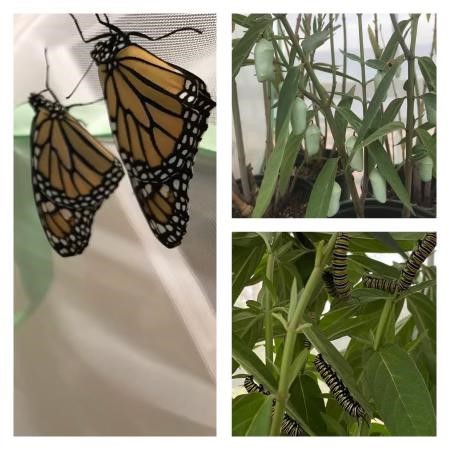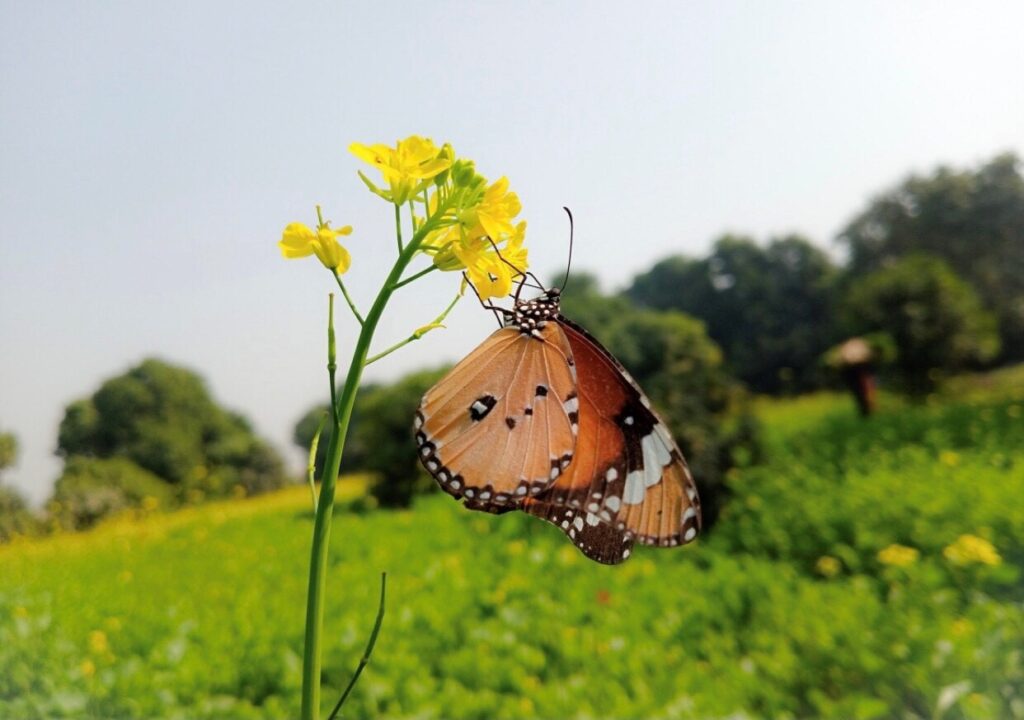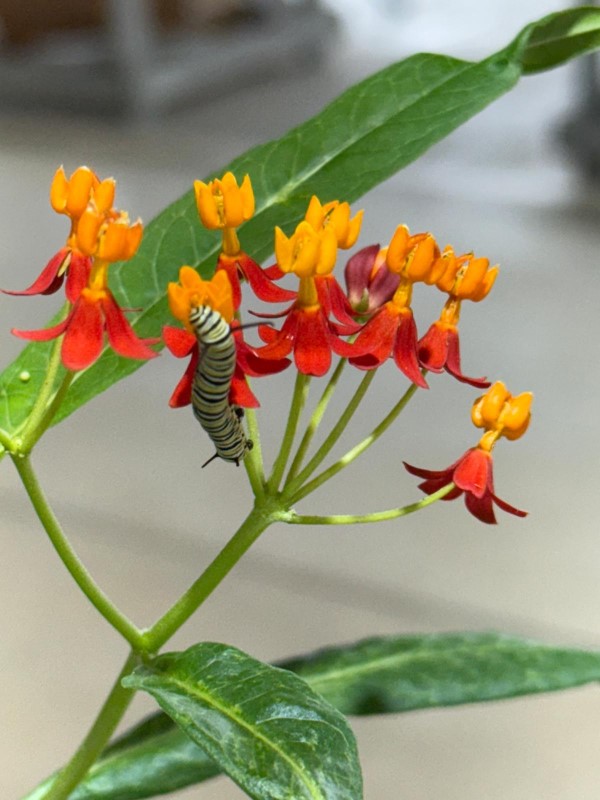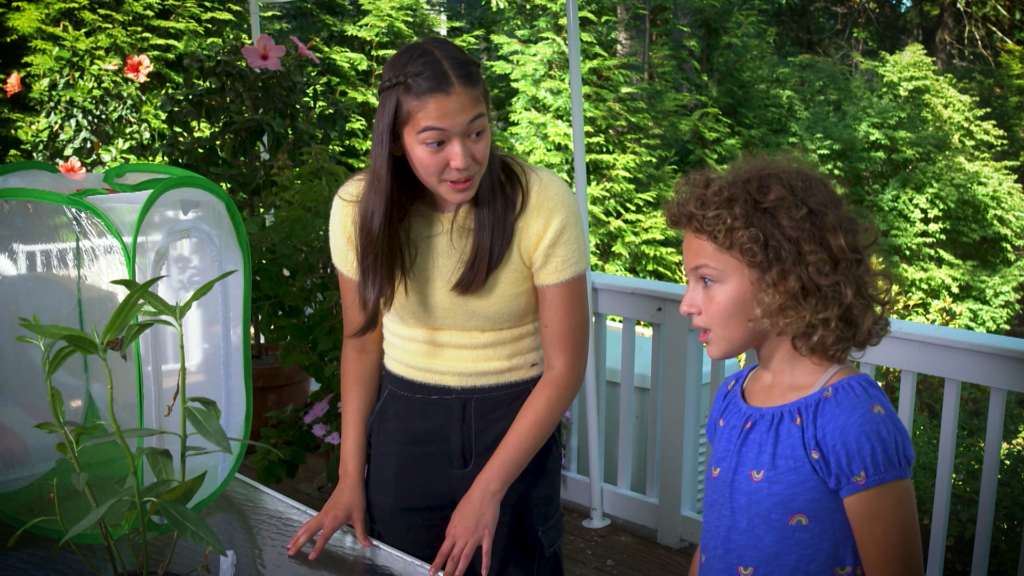
They pollinate by transferring pollen from one flower to another as they feed on nectar. Here’s how it works step by step:
- Attracted to Flowers: Butterflies are drawn to brightly colored flowers (especially white, red, yellow, and purple) with a strong scent and a wide landing platform.
- Nectar Feeding: They land on the flower and use their long, straw-like tongue (called a proboscis) to reach deep into the flower for nectar.
- Pollen Transfer: While feeding, their legs and bodies may brush against the flower’s reproductive parts—the stamens (which produce pollen) and the pistils (the pollen-receiving part). Some pollen sticks to the butterfly.
- Next Flower Visit: When the butterfly visits another flower, some of that pollen rubs off onto the new flower’s pistil, enabling fertilization.
Butterflies aren’t as efficient as bees when it comes to pollination because they have slender bodies and less surface area for pollen to stick to, but they still play an important role—especially for certain wildflowers that depend on them.
Raising butterflies is magical no matter the species — but there’s something truly special about the Monarch experience.

1. A Real Connection to Nature
• Monarch caterpillars eat only milkweed, which means you get to raise them on a living, growing plant — not a cup of artificial diet (see the video below).
• This gives you a front-row seat to real garden ecology, pollinator awareness, and plant-insect interaction.
• Painted Ladies are usually raised on a paste-like artificial diet in a cup — quick and convenient, but far removed from nature.
2. A “Luckier” Lifecycle
• Painted Ladies can feel like an “assembly line” experience: caterpillars in a cup, butterflies out in a week, and done.
• Monarchs offer a longer, more thoughtful journey — from caterpillar to chrysalis to butterfly, often over 2–3 weeks.
• Watching a Monarch chrysalis shift from jade green to transparent gold is truly breathtaking — and worth the wait.
3. Conservation You Can See
• Monarch populations are in decline, and raising them helps support their survival.
• By planting milkweed and raising Monarchs, you’re making a real difference in pollinator conservation.
• Painted Ladies aren’t threatened, and raising them doesn’t have the same ecological impact.
⸻
In short:
Painted Ladies are fun. Monarchs are unforgettable.
With Monarchs, you raise more than a butterfly — you grow a connection to the natural world, and become part of something bigger.
To download the Classroom Comparison Chart, click here.
The monarch butterfly migration is one of the most remarkable natural phenomena in the world. Monarchs (Danaus plexippus) undertake a multi-generational migration spanning thousands of miles across North America. Their journey is unique because no single butterfly completes the entire round trip—rather, it takes four to five generations to complete the full cycle.

The Migration Cycle
Spring Migration (Northward Journey)
• In March and April, monarchs begin their journey north from Mexico and Southern California, where they have spent the winter in dense forest groves.
• These butterflies lay eggs on milkweed plants across the southern U.S. before dying.
• The next generation hatches, matures, and continues the journey north.
Summer Generations
• Over the next few months (May to August), multiple generations are born in the U.S. and Canada.
• Each new generation moves farther north, following the growth of milkweed, their host plant.
• These summer monarchs live for about 2-6 weeks and continue reproducing.
Fall Migration (Southward Journey)
• The last generation of the year, known as the “super generation,” is born in late summer (August-September).
• Unlike their short-lived ancestors, these butterflies can live up to 8 months.
• They do not reproduce immediately; instead, they focus on flying up to 3,000 miles south to their wintering grounds.
Overwintering in Mexico and California
• Monarchs from eastern North America migrate to the mountains of central Mexico (specifically, the oyamel fir forests in Michoacán).
• Monarchs from western North America migrate to coastal California, clustering in groves of eucalyptus, cypress, and pine trees.
• They remain in their overwintering sites until the weather warms up in February or March, when the cycle begins again.
Threats to Monarch Migration
• Habitat Loss: Deforestation in Mexico and urban expansion in North America threaten critical habitats.
• Declining Milkweed Populations: Monarchs depend on milkweed to lay eggs, but widespread herbicide use has drastically reduced its availability.
• Climate Change: Unseasonal temperatures, severe storms, and droughts disrupt migration timing and survival rates.
How to Help Monarch Butterflies
• Plant native milkweed and nectar-rich flowers.
• Avoid using pesticides that harm butterflies and caterpillars.
• Support conservation efforts to protect overwintering sites.
• Participate in citizen science projects to track monarch populations.
Monarch migration is both fragile and awe-inspiring. Scientists continue to study this phenomenon, and conservationists work to ensure future generations can witness this incredible journey.
LILESVILLE, N.C., April 3, 2025 (SEND2PRESS NEWSWIRE) — Whimsical Wings Farms, a leader in butterfly conservation and pollinator education, is proud to announce a breakthrough in plant shipping: a patented box designed to safely deliver one-gallon milkweed plants. Paired with the farm’s engaging Monarch Butterfly Lifecycle Kit, the innovation supports nationwide habitat restoration efforts and hands-on environmental education.

Read the Press Release here.
As spring blooms, many of us are eager to tidy up our lawns. But before you mow down that lush patch of clover or reach for weed killer, here’s something important to consider:
That clover isn’t a weed — it’s a lifeline.

Pollinators Are in Trouble — Your Lawn Can Help
Pollinators like bees, butterflies, and other beneficial insects are facing an alarming decline. According to conservation groups, species like the Monarch butterfly and native bumblebees are dangerously close to extinction. The culprits?
- Pesticide use
- Habitat destruction
- Loss of food sources, especially in early spring
Clover and wildflowers provide much-needed nectar when other plants haven’t yet bloomed. By letting these plants thrive, you’re offering a sanctuary to creatures vital to our food system and ecosystems.
A Simple, Powerful Way to Make a Difference
This spring, you can turn your yard into a safe haven for pollinators by taking three simple steps:
- Skip the pesticides – Even “natural” ones can be harmful to pollinators.
- Let your clover grow – Clover is not only beautiful, but rich in nectar.
- Welcome the wild – Embrace a bit of nature’s messiness. It’s buzzing with life.
When you do this, you’re not just helping bees and butterflies – you’re also improving your soil, increasing biodiversity, and reducing the need for chemical lawn care.
Your Yard Can Be a Small Patch of Hope
In a world that’s increasingly challenging for wildlife, your backyard can be part of the solution. Every flower matters. Every patch of green makes a difference.
This spring, make a bold, beautiful choice:
Plant kindness. Let it bloom.
#SaveTheBees
#PollinatorFriendly
#NoPesticides
#CloverLawn
#WildlifeGardening
#OrganicLawnCare
#MonarchButterfly
#EcoFriendlyYard
#BackyardHabitat
#LetItGrow
Artificial pollination is not replacing natural pollinators but rather supplementing them in situations where they are declining or insufficient. Natural pollinators, such as bees, butterflies, and birds, play an irreplaceable role in ecosystems, supporting biodiversity and agricultural production. However, due to habitat destruction, pesticide use, climate change, and diseases, many pollinator populations are in decline.

Have you noticed fewer butterflies and bees in your garden lately? The decline in pollinators is becoming more apparent as urban sprawl and habitat loss continue to threaten their survival. These essential creatures, once abundant and vital to pollinating crops and gardens, are now struggling to find the host plants they depend on. In response, some large-scale farms are even turning to artificial pollination methods to sustain their crops. If we don’t take action, future generations may never experience the simple joy of watching butterflies flutter through their backyards. We must do better. Monarch butterflies, in particular, are at risk, and one of the simplest ways to support them is by planting milkweed—the only plant their caterpillars can eat. If you’re concerned about invasive species, don’t worry—there are many stunning ornamental varieties of milkweed that are non-invasive and perfect for home gardens. By planting just a few milkweed plants, you can make a difference. Let’s work together to protect these beautiful pollinators before they disappear from our world.


Butterflies taste with their feet! Their sense of taste is 200 times more powerful than a human being. Once the butterfly lands on the plant, it can immediately determine if it’s good to eat. It also helps them determine if the plant is suitable for their babies to hatch and grow.
Each autumn, Eastern Monarch butterflies embark on an incredible journey – migrating thousands of miles from North America to their wintering grounds in the mountains of central Mexico. But did you know these iconic butterflies need your help to make the trip?

Monarchs Need Milkweed and Nectar-Rich Plants to Survive
As summer fades, it becomes harder for Monarchs to find the food sources they rely on to fuel their migration. By planting the right fall-blooming flowers in your yard or garden, you can give these butterflies the boost they need.
What to Plant to Support Monarch Migration:
- Milkweed (Asclepias spp.) – The essential host plant for Monarch caterpillars.
- Aster (Aster spp.) – A vibrant, nectar-rich alternative to mums.
- Goldenrod, Joe-Pye Weed, and Coneflower – Late-blooming favorites full of nectar.
These plants provide both nectar for adult Monarchs and habitat for future generations, playing a key role in their survival.
Skip the Mums – Try Asters Instead
While chrysanthemums (mums) are a popular fall flower, they’re often low in nectar. A better choice? Native asters — they have a similar look but offer abundant nectar that supports a wide range of pollinators, especially migrating butterflies.
Found a Tagged Monarch? Here’s What to Do
If you’re lucky enough to spot a tagged Monarch butterfly in your yard, take note of the tag number and report it to Monarch Watch. This incredible citizen science program tracks Monarch migration patterns and population health — and your observation helps researchers monitor trends and survival rates across North America and Mexico.
Your Garden Can Make a Difference
Helping Monarch butterflies isn’t complicated. By planting native flowers and avoiding pesticides, your garden becomes a crucial refueling station on their long journey south.
Let’s work together this fall to:
- Support native pollinators
- Contribute to conservation efforts
- Make your yard a Monarch waystation
Small changes in your garden can lead to big differences in the wild.
#MonarchButterflyMigration
#PlantMilkweed
#PollinatorFriendlyGarden
#NativePlantsForPollinators
#SaveTheMonarchs
#FallGardeningTips
#AstersNotMums
#MonarchWatch
#ButterflyMigrationSupport

Tune in Friday, February 25 to @PBSKIDS at 7pm ET to learn all about animal migration – and catch a special cameo appearance of a few Whimsical Wings Farms monarchs – with the premiere of all-new math and environmental adventures on the award-winning series, @Cyberchase!
Whimsical Wings Farms worked closely with the talent and Executive Director of Cyberchase to make this episode a meaningful one for Monarch lovers. All butterflies, plants and supplies in the segment were provided by the farm.


